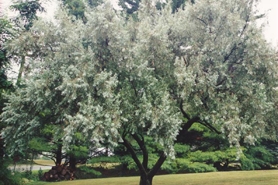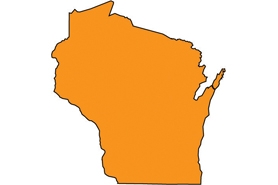Russian olive
(Elaeagnus angustifolia)
Small deciduous tree with silvery foliage. Russian olive can reach 30 feet. Twigs have a terminal spine and are covered by small silvery scales.
Other names for this plant include:
- Common names: oleaster
- Scientific names: E. hortensis, E. moorcroftii, E. orientalis
Classification in Wisconsin: Restricted
- Ecological Threat
-
- Russian olive invades open areas, including wet areas. It uses water more quickly than native species and can dry out riparian areas.
- Alters nutrient cycling by adding nitrogen to the soil.
- Identification
-
Leaves: Simple and alternate. Leaves are silver on both sides, longer and more lance-shaped. It has a gray-green hue when seen from a distance.
Flowers: Tube- or bell-shaped, fragrant and borne in leaf axils. Blooms in late spring. Russian olive flowers are yellow inside and silver outside.
Fruits & seeds: Fruits are yellow, dry and olive-like; birds readily disperse them.
Roots: Associated with nitrogen-fixing bacteria. Cutting or other damage causes root suckering.
Similar species: Two native buffaloberries, silver (Sheperdia argentea) and russet (S. canadensis), have silvery foliage but their leaves are opposite. Autumn olive (Elaeagnus umbellata; invasive) grows 20 feet tall. Its leaves are dark green on top and silver-gray on the underside, lance-shaped or elliptic, with entire, wavy margins. Flowers are creamy-white to light yellow; fruits are small, fleshy, egg-shaped, pink to red with silver scales. Autumn olive tends to invade open and forested natural areas, roadsides, and agricultural fields.
- Control
-
Mechanical: Pull seedlings. Cutting, mowing and burning are not recommended because plants will resprout unless followed up with chemical control.
Chemical: Treat foliage, cut surface or girdled stem with glyphosate, triclopyr ester, or metsulfuron-methyl with a surfactant. Basal bark application of triclopyr ester can also be practical.
- Resources
- Sources for content:
- Czarapata, Elizabeth; Invasive Plants of the Upper Midwest: an illustrated guide to their identification and control. The University of Wisconsin Press. 2005. Pg. 90
- Colorado State Parks. Best Management Practices Weed Profile: Russian olive.
- Muzika, Rose-Marie and Jil M. Swearingen. Plant Conservation Alliance, Alien Plant Working Group. Least Wanted: Russian olive [exit DNR]. Last revised July 7, 2009.


